Elysian Acoustic Diva - Quintessential good IEM
Few IEMs have been hyped up in my small audio circle than Elysian Acoustic Labs Diva. A friend predicted that I will fall head over heels for this IEM. Others firmly believed that this would “kill” my U12T. A fellow reviewer jumped through all sorts of hoops to get himself a CIEM of the Diva.
Finally, the stars align (by @Damz87) and I have my hands on a sample of Diva 2023 revision. Does it live up to the immense expectation?
It’s complicated. Forewords ===
- What I look for in an IEM is immersion. I want to feel the orchestra around me, track individual instruments, and hear all of their textures and details. I’m not picky about tonality, as long as it does not get in the way of immersion.
- I rate IEMs within with a consistent scale from 1 (poor) to 3 (good) to 5 (outstanding). Ratings are assigned by A/B tests against benchmark IEMs, regardless of the retail price.
- Ranking list and measurement database are on my IEM review blog.
- Terms used in my reviews are consistent with the glossary by Headphonesty
- This impression is possible thanks to Australian Head-fi Tour. Special thank you to @Damz87 for arranging the tour.
- The units would be sent to the next reviewer after this impression.
- Elysian Diva 2023 retails at $1599 at the time I write this impression.
Sources for listening tests:
- iBasso DX300 (for all A/B tests)
- FiiO K7
- Hidizs XO
Local FLAC files ripped from CDs or bought from Qobuz were used for most casual listening and A/B tests. My playlist for A/B tests can be found on Apple Music here.
All of my listening was done with Spinfit CP145 ear tips. I listen at a medium volume. I usually turn up the volume until the midrange is fully audible and detailed, unless a treble peak or overwhelming bass prevents me from doing so.
Specs
- Driver: 6 BA drivers, 4-way crossover
- Connector Type: Pentaconn (NOT MMCX)
- Impedance: 4ohm@1kHz
- Sensitivity: 100dB@100mV@1kHz
Build and Comfort
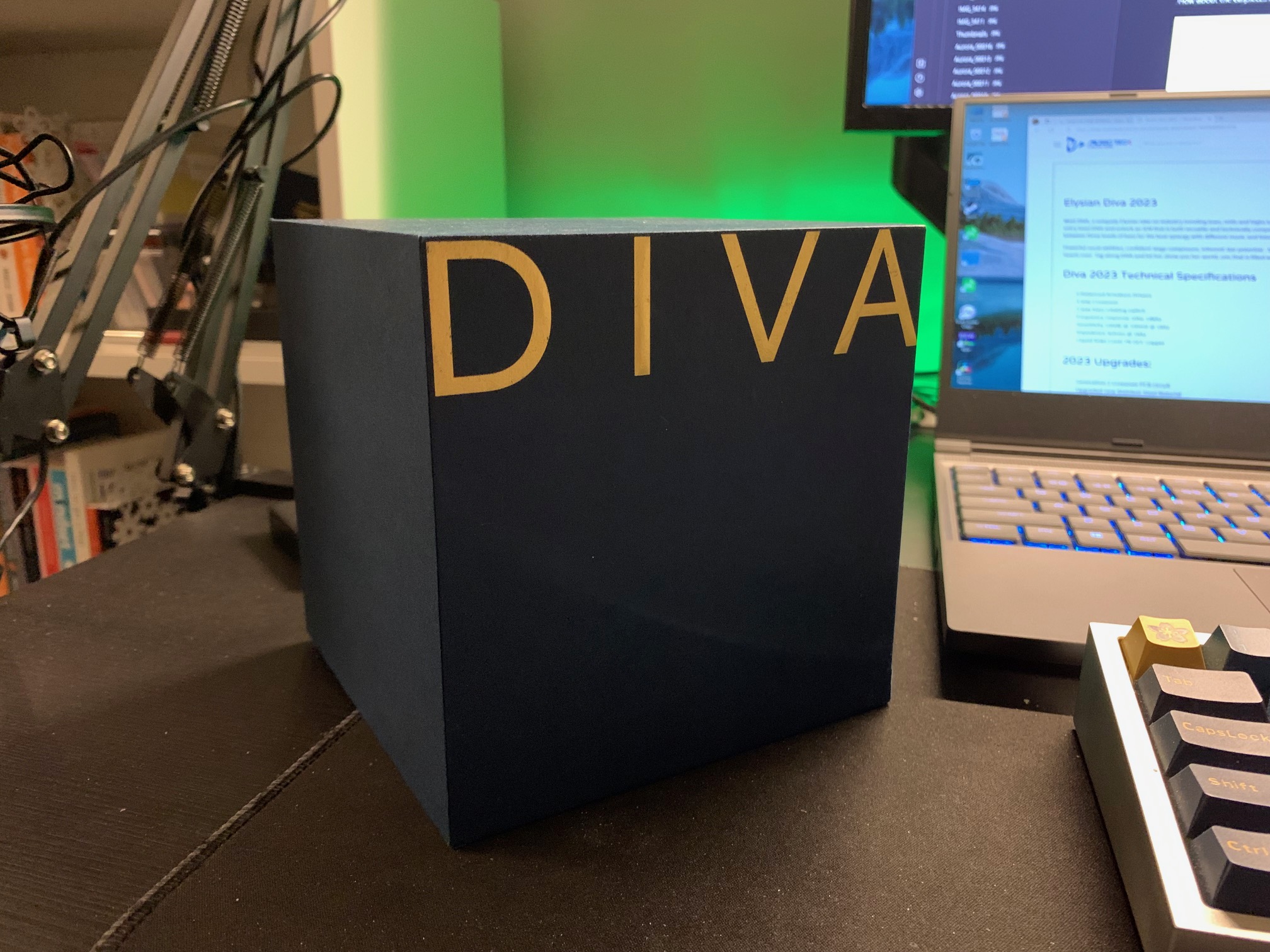


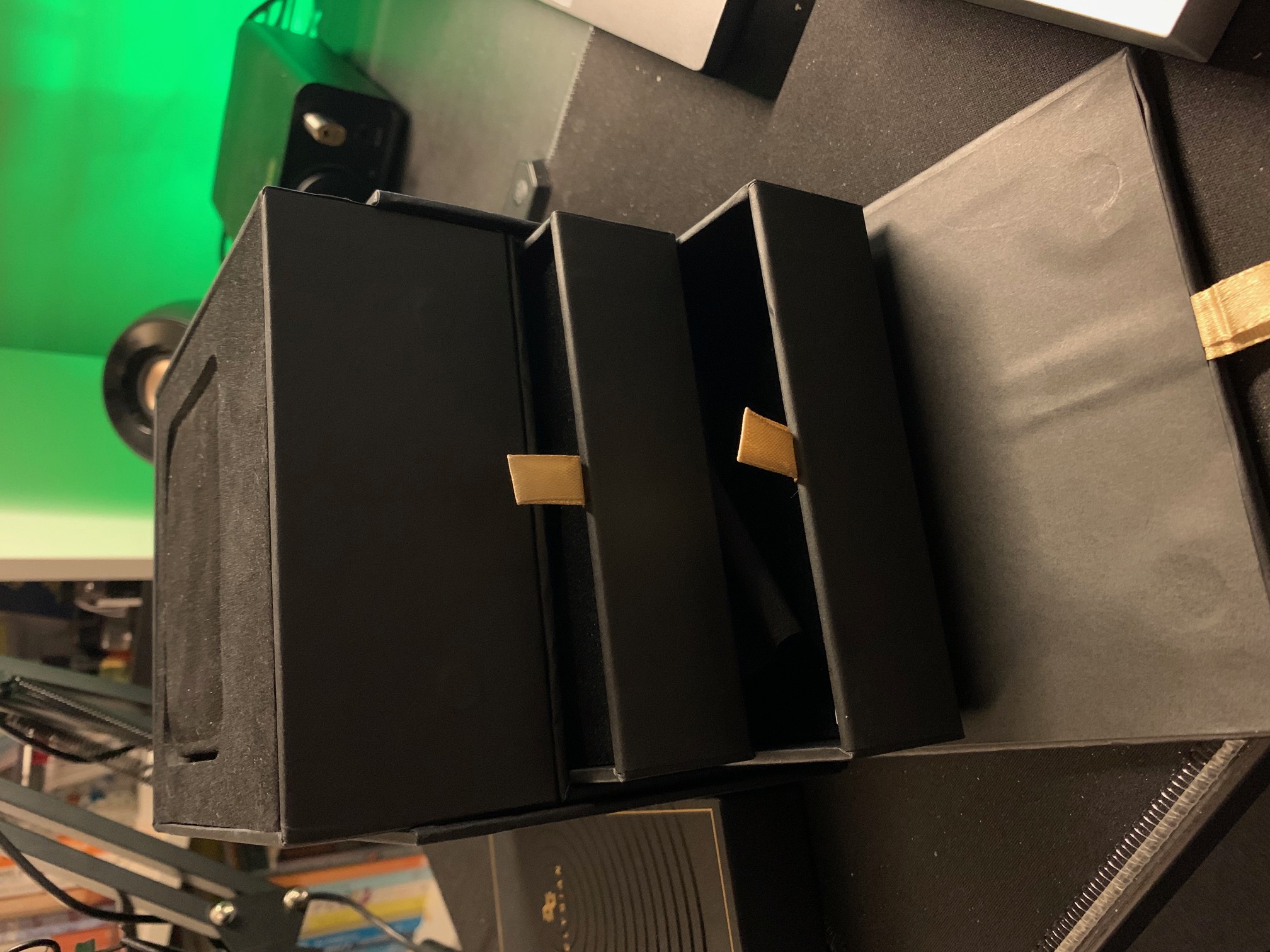
For some unknown reason, I have always had the impression that Elysian IEMs do not have any packaging. That couldn’t be further from the truth as Diva 2023 has the most elaborated and luxurious unboxing experience I have ever seen in real life for an IEM product. Good job, Elysian! USD $1600 is extremely expensive for a pair of IEM. This level of consideration is a must.
Inside the box, you find
- Small carrying case with felt fabric cover (a dust magnet)
- Effect audio Ares 4W cable
- A set of Spinfit W1
- An IEM cleaning tool
- A tiny screw driver to change the bass level
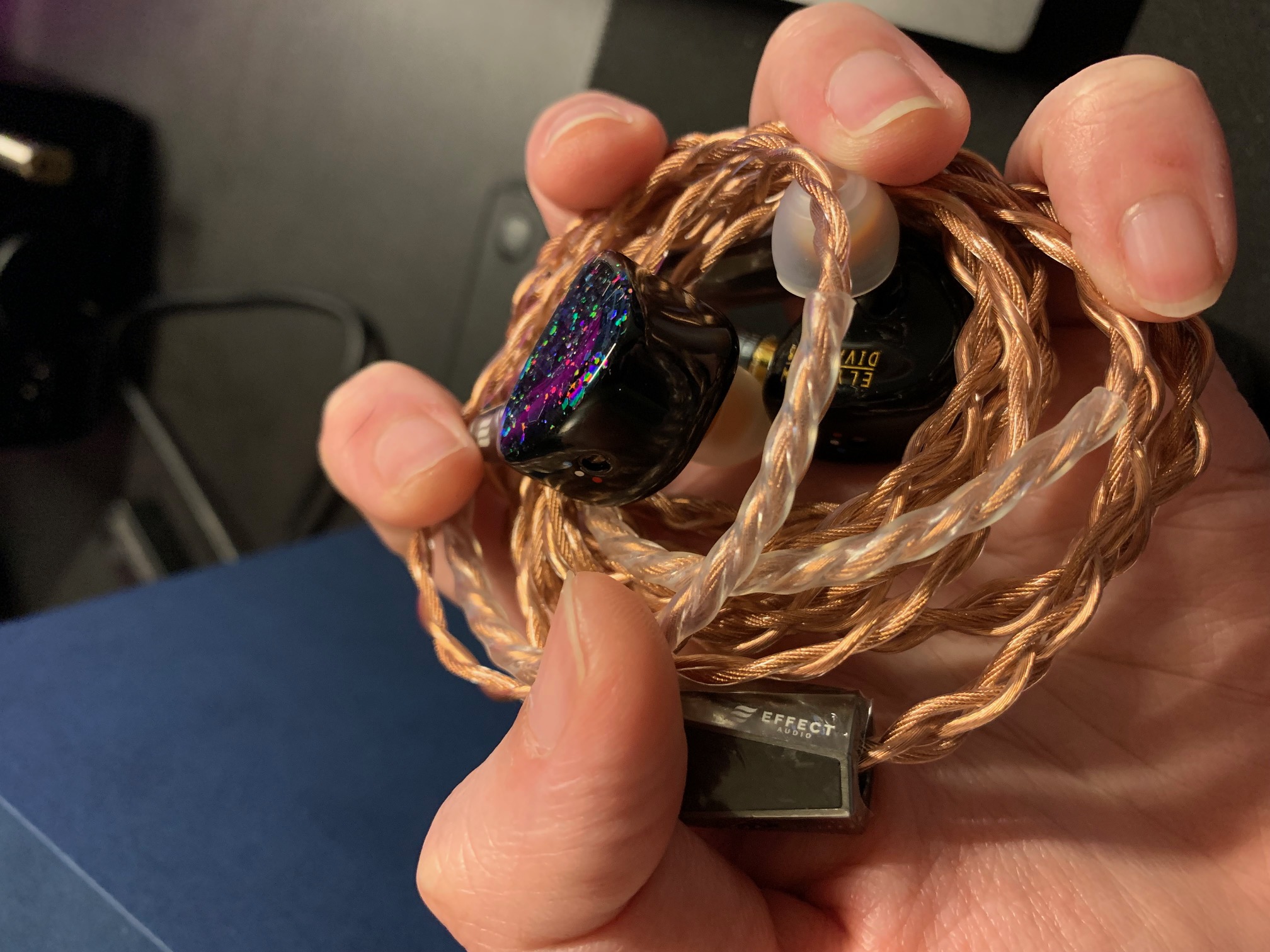

The earpieces of Diva 2023 are much, much larger than what I expected looking at photos on the Internet. The nozzles of Diva 2023 are also thick. Narrower eartips like Final Audio Type E are unusable. Spinfit W1 are quite stretched, though usable. Only wider tips like CP145 and CP155 can fit the nozzle comfortably. The size of the nozzle makes it harder to fit Diva properly (deep enough for the earpieces to rest against the concha). You might need to experiment with different tips to find a good one.


Despite having vent on the shells, Diva 2023 feel like a fully sealed BA IEM. I experienced pressure build up after half an hour or so. This problem, together with the size of the earpieces, creates a relatively stuffy and uncomfortable experience for me. I much prefer the smaller size and better ventilation of the sister unit of Diva, the Effect Audio Gaea.
Noise isolation is strong with Diva 2023. However, because the earpieces are large and stick out quite a bit from the ears, I have a lot of wind noise when taking a walk.
Tonality
Frequency response of Diva 2023 across all bass boost settings. Measurements were done with an IEC-711-compliant coupler and might only be compared with other measurements from this same coupler. Visit my graph database for more comparisons.
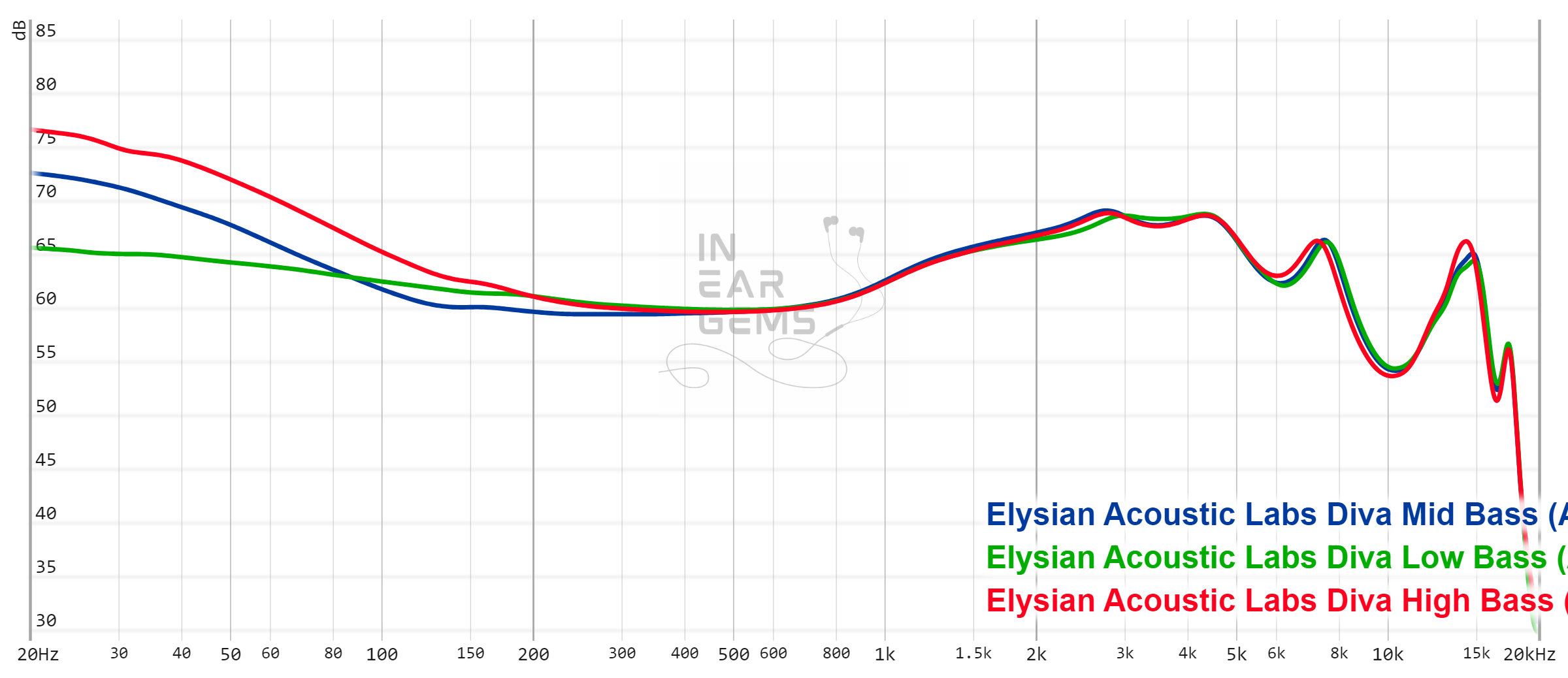
The tuning of Diva 2023 is the quintessential “well-tuned” signature. It is easy to love, or at least hard to hate.
- Proper ear gain boost: there is enough emphasis in the upper midrange, done in the (relatively) right way, to ensure that vocals and midrange instruments are clear and present without becoming shouty or harsh at any point.
- Treble gradually rolls off after the ear gain: subdue harshness and sibilance, and mitigate any sort of timbral problem due to improper balance between treble and midrange (e.g., too much 8kHz over 4kHz)
- Bass is emphasised but not overwhelming: many “well-tuned” IEMs ignore the bass to pursue a “reference” tonality, without taking into consideration that IEM’s bass must be boosted to compensate for the loss of physical sensation when listening to loudspeakers. That’s not the case with Diva 2023.
- Lower midrange is not thin (but not muffled and muddy): another pitfall of many “well-tuned” IEMs is that they make the contrast between lower and upper midrange too strong, making the overall tonality razor thin. Again, that’s not the case with Diva 2023. In fact, I would say the midrange of Diva 2023 is tastefully thick. Perhaps a touch more than I usually like.
It should be noted that Diva 2023 has 3 bass options. You use the included screwdriver to rotate a switch on the back of the earpieces. All of my impressions above are based on the middle (default) option. I find the less-bass option too bland and the more-bass option is too muffled. Still, it’s good that you have options.
One note about the measurement: I finished all of my subjective impressions before measuring. I was quite surprised by how the Diva measures. Looking at the ruler-flat midrange and the deeply tucked bass shelf, you wouldn’t expect Diva 2023 to have such natural-sounding bass and the proper note weight. In fact, if one only look at the graph, one would predict that Diva is the thin and lifeless IEM rather than the Monarch II and Gaea, the ones that usually receive that criticism.
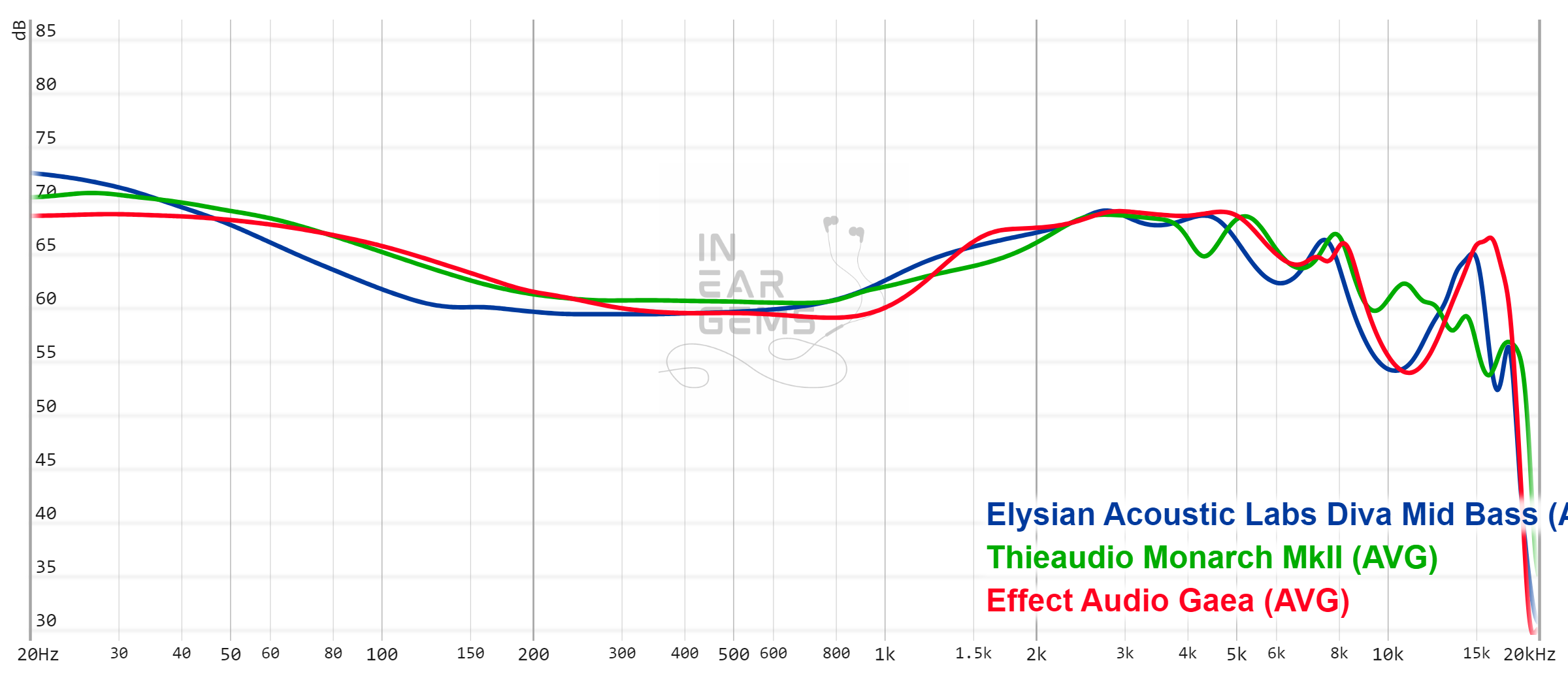
I suspect the way Elysian tunes the ear-gain boost contributes to this impression. The ear-gain tuning of Diva does exhibits the early boost starting from around 600Hz and it has more energy around 1.5kHz, similarly to the so-called QDC-tuning that is used by quite a few IEMs this year, such as the AFUL Performer8 and Dunu SA6II. This tuning styles tends to push the midrange forward and gives it more weight, without boosting lower midrange .
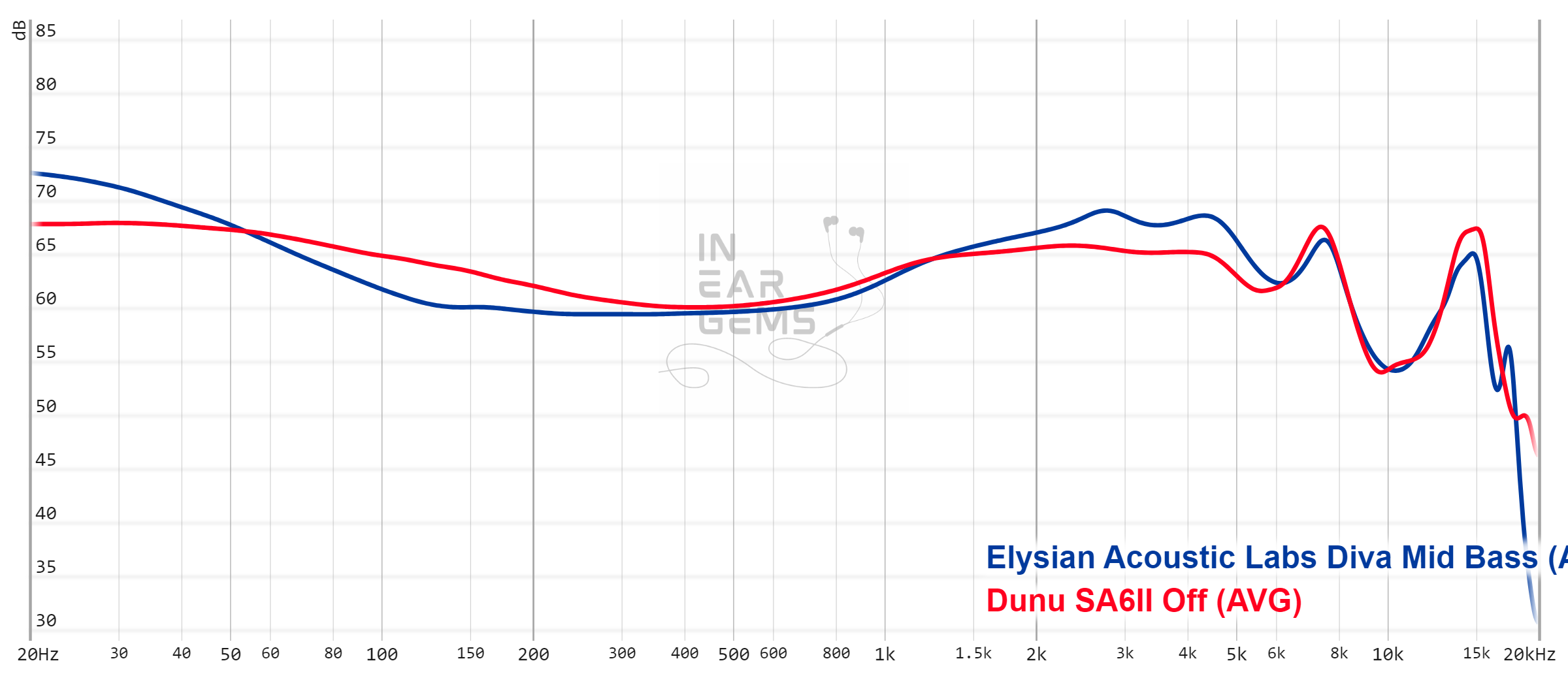
Bass and Dynamic
A good pair of IEMs/earbuds/headphones should be able to convey, even emphasise, the sense of rhythm and the ebbs and flows of music. In general, this energy requires IEMs to be able to convey rapid volume swings on the downbeat of an orchestra or the leading edge of bass note. It also requires tactile physical sensation of the bass, and the sense of rumble and texture accompanying the bass drops. An IEM can have loud bass, but still fail to convey energy should it lack other features above.
The bass of Diva 2023 is quite interesting.
Think of it this way. Diva 2023 (BA bass) sounds more like dynamic driver whilst the Gaea (dynamic driver bass) sounds more like BA. Both are great in their own way. The Gaea concentrates most of the energy of a transient to the leading edge, creating a snappy transient response that feels like whip cracks. The Diva has rounder and less defined leading edge, but with a strong physical sensation of the bass slam right after the leading edge. The decay of bass notes is also more highlighted and slightly more detailed (though if I am very nitpicky, I would say the Gaea has more texture in the bass decay).
In other words, the BA bass of Diva has very similar presentation to the BA bass in 64 Audio IEMs. Rounder attacks, more physical slam.
Soundstage Imaging
Soundstage imaging is where I have the most problem with Diva.
Let’s talk about the good part first. Diva has no problem presenting the background element of the recordings, such as the reverberation in classical recording or the cheers of audience in live recording. It also does a decent job at separating the foreground from the background to convey a sense of layering and distance.
The problem with Diva, at least for me, is that it is tuned for a cohesive presentation rather than separation. That means there is less empty space between instruments and the boundary between them are less clear. The emphasis on midrange also pushes the foreground instruments forward and generally keeps them inside the head. Even with the most spacious live recordings, Diva does not sound large.
Resolution
As I alluded to earlier, Diva does not have the sense of tack sharp separation. Note attacks are somewhat rounded, and instruments do not have razor sharp boundaries. With that being said, Diva does not sound dull, muffled, or muddy. It simply does not have the crystalline clarity like IEMs tuned specifically for that purpose, such as the Gaea.
On the other hand, detail retrieval of Diva is great. Whenever I pay attention, I can appreciate an extra level of nuances and textures across the frequency, from midrange instruments and vocals to cymbals and hats to bass guitars.
Comparisons
Effect Audio X Elysian Acoustic Labs Gaea (4BA + 1 DD):
- Gaea has explosive, whip cracking presentation that can be divisive. Diva is milder and easier to listen.
- Gaea earpieces are smaller and better vented.
- Gaea has an edge in clarify and separation. Diva is slightly better at revealing detail. The true resolution of both is roughly at the same level.
- The soundstage of Gaea feels larger in all dimensions and more open.
AFUL P8 (7BA + 1DD):
- Diva is significantly more difficult to drive.
- Alternative take on the “well-tuned.” Diva is tastefully adjusted from Harman/Diffused Field. P8 is inspired by the QDC house sound. Simply put, Diva feels more “V-shape” whilst P8 has thicker and more forward midrange (500-1000Hz).
- Diva has more generous bass than P8. Another interesting case where Diva BA bass feels more DD and P8 DD bass feels more BA (emphasising the leading edge).
- Diva is half step ahead of P8 in overall resolution.
- The real reason P8 is in this comparison is because its soundstage invokes the same “we were on the verge of greatness, we were this close” feeling.
64 Audio U12T with MX module:
- U12T has a significant edge in terms of comfort.
- The physical sensation of physical slam after the more rounded leading edge of transient is similar between Diva and U12T, even with MX module.
- U12T emphasises the leading edge of cymbals and hats much more than Diva. This can be good or bad depending on your taste.
- U12T is half step ahead of Diva in overall resolution. However, the gap is small between these top performers, so I don’t think resolution would be a deciding factor in choosing either.
- This is how you do an outstanding soundstage on IEM.
My Take
Should you add a Diva 2023 to your collection? To answer this question, you need to ask yourself what you think when you hear the term “soundstage.” If you are in the camp “IEM’s soundstage is a meme” or “who care! IEM never sounds like speakers anyway”, then go ahead. To me, Diva 2023 is the quintessential “great IEM” with natural and versatile tonality, great bass response, and great detail retrieval without any harshness of shrill. If you don’t mind the large shells and the potential pressure build up of a sealed IEM design, Diva 2023 might be the one for you.
But if you, like me, pay a lot of attention to how the sonic picture of your music is presented within that limited head stage of the IEM form factor, if you want your instruments to have laser focus and razor-sharp boundary, if you want the stage to feel expansive when listening to spacious recording, then Diva 2023 might not cut it, despite all the great qualities.
Absolute Sonic Quality Rating: 4/5 (Tonality: 4, Resolution: 4, Bass: 4, Stage: 3) - Great
Bias Score: 3/5 - I’m lukewarm about this IEM

